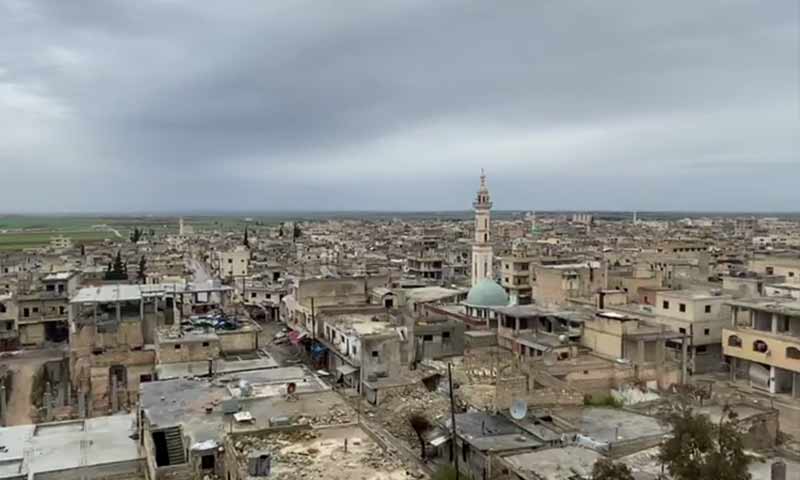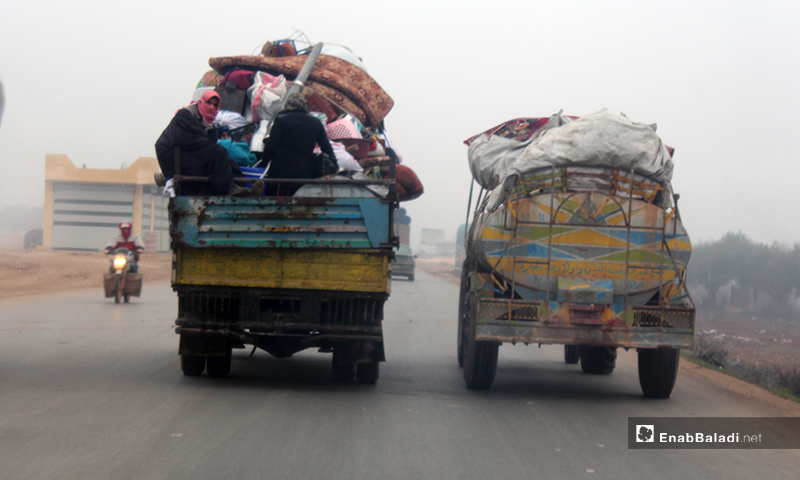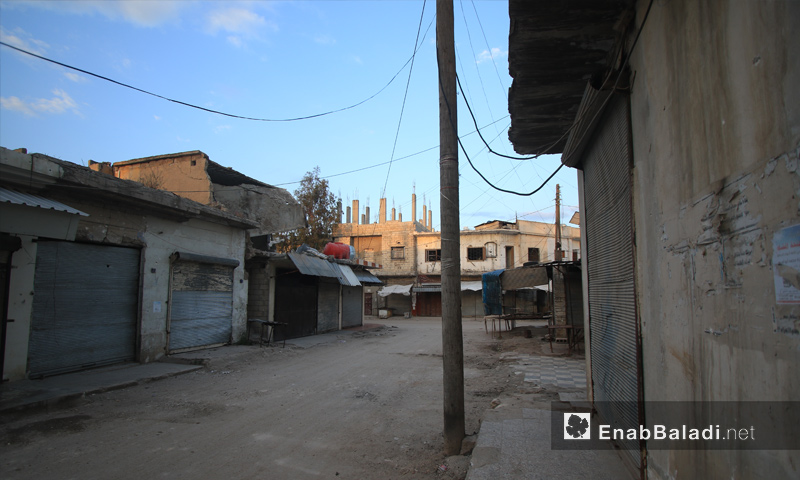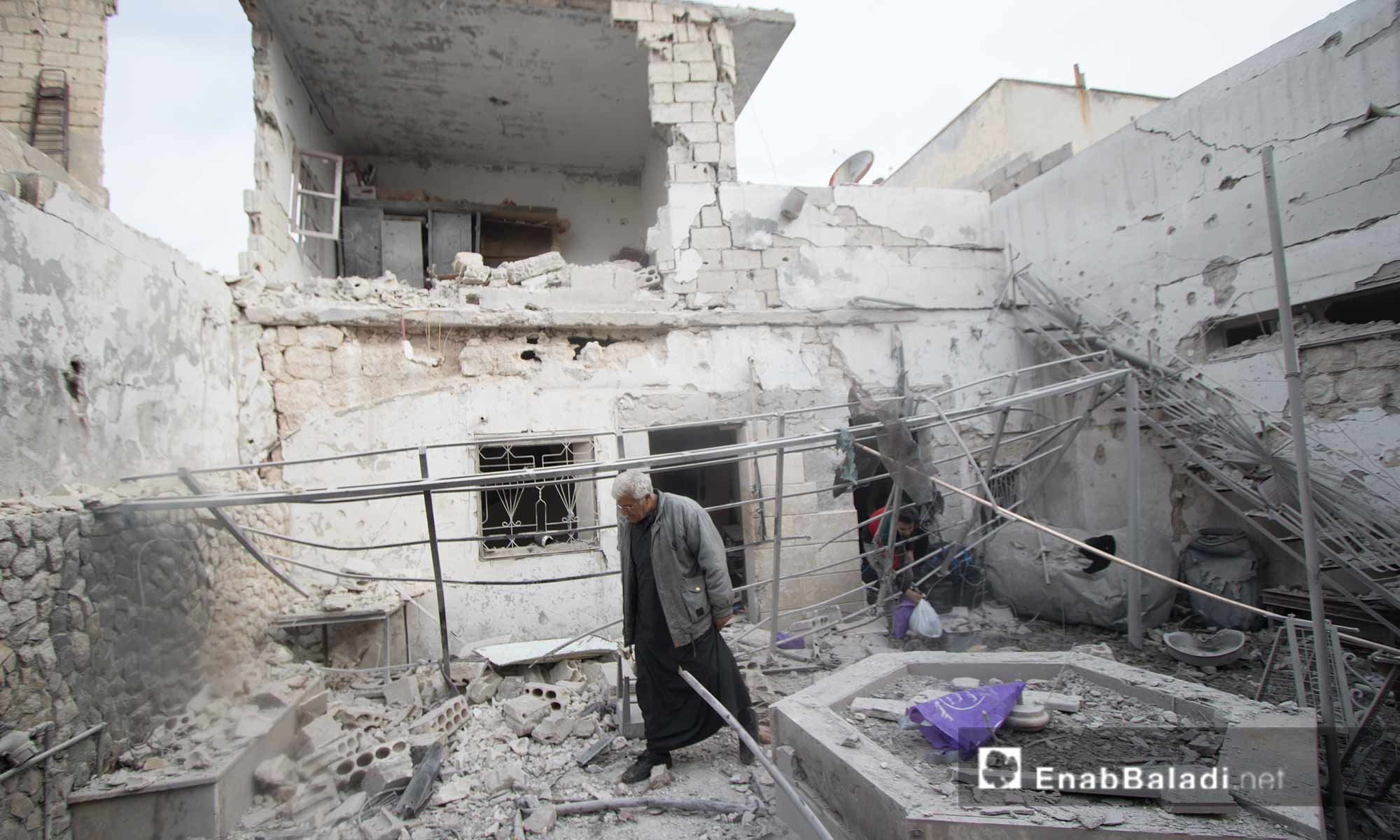



Enab Baladi – Ninar Khalifa
“My all life-savings are gone in one picture.” With these words, Khunais al-Issa, a resident of Saraqib city in Idlib countryside, commented on a recently circulated video recording showing the demolition of house ceilings by the Syrian regime forces in Saraqib to steel iron bars from them.
The recording, which was circulated by social media activists, shows people in civilian clothing demolishing the roof of one of the civilians’ houses with axes.
Al-Issa told Enab Baladi, “I have two houses in Saraqib, I saw them demolishing my first house located to the west of the automatic bakery with their axes, and they will surely complete the demolition operations of my second home.”
Al-Issa watched the video in a social media group. It was filmed by one of the military observatories stationed in Afes on the outskirts of Saraqib.
He added, “At first, I did not believe that what was shown in the video was my house, which I built brick by brick. All of Saraqib’s houses were destroyed and stolen, one can only say “God is sufficient for us, and how fine a trustee.”
The city of Saraqib is located in the southeast of Idlib city. It is of great importance as it links Damascus and Aleppo and has an area of about 17,000 hectares (170,000,000 m²,) about 50 kilometers from Aleppo city. Saraqib is an intersection on the two international highways of the “M5,” which links between Damascus and Aleppo and the “M4” connecting between Aleppo and Latakia.
The intersection of the M4 and the M5 international highways in Saraqib in Idlib countryside (The coordination of the revolution in Binnish/ Mohammed Haj Kaddour)
Shaher al-Mohammed avoids getting any information about his house in Saraqib city. He pointed out to Enab Baladi that some displaced residents received information or pictures of their destroyed, burned, or stolen houses from people who managed to get military permission to enter the city for two or three hours. Those people took pictures of theirs and their relatives’ houses.
Al-Mohammed confirmed that all the houses in Saraqib were damaged without exception, following the vicious military attack that the city witnessed last February. He added, many people managed to get into Saraqib and took pictures when the opposition factions regained control of the city on 27 February. In the pictures, the houses appeared to be badly damaged, and most of them were destroyed.
Seven months after the stealing operations in Saraqib, the city had nothing left in it, no furniture or household items; therefore, the regime’s forces turned to breaking the tiles and destroying the roofs to get iron out, as any house has at least three tons of iron in average, and they will get a lot of profits upon selling them.
Despite the shrinking hope, al-Mohammed said, “I have never found any wall similar to those of Saraqib, God willing, we will return to our houses.”
On 16 of August, a video recording was released showing destruction scenes in Saraqib city. The video received many comments, one of which said, “Saraqib is destroyed, it would never be rebuilt, not even in 500 years.” While another comment said, “all areas of Aleppo are destroyed, not only Saraqib.”
Last February, Saraqib witnessed many attack and retreat battles between the Syrian regime, supported by Russian aircraft, and the opposition factions supported by Turkish forces.
The factions and the regime forces alternated control over the city of Saraqib. On 7 February, the regime re-controlled the city before the factions launched a counter-attack through which they managed to restore power over Saraqib on the 27th of the same month. However, on 3 March, the regime forces were able to control Saraqib permanently after intense battles in the city. The regime forces also extended its control over the entire international highway “M5,” which links Damascus and Aleppo.
On 5 March, the Turkish president Recep Tayyip Erdogan and his Russian counterpart Vladimir Putin signed a ceasefire agreement, which helped maintain the current military map.
The “Syrian Network for Human Rights (SNHR)” published a report on 29 May, in which it documented the destruction and forced displacement of Idlib province during the vicious attack launched by the regime and its Russian ally from early December 2019 to March 2020, particularly in the cities of Saraqib and Maarat al-Numan.
The report indicated that the displacement of the two cities’ residents is related to the loss of their houses, belongings, and shops and the deliberate destruction operations that hit the markets, medical points, and “civil defense” centers.
The SNHR’s report reviewed visual evidence of the devastation of Saraqib city. It considered the city as a model indicating that the destruction of cities and the displacement of their residents is a goal in itself by the regime, aimed at “inflating the harshest possible punishments on all those who demand political change.”
The international law defines the forced displacement as “the forced and illegal eviction of a group of individuals and residents from the land on which they reside.”
Article 49 of the “Fourth Geneva Convention of 1949” prohibits the collective or individual forced transfer of persons, or their eviction from their areas of residence to other territories, except when this is in their interest to spare them the risks of armed conflict.
Article 7 (d) of the Rome Statute of the “International Criminal Court” states that “the removal or forcible transfer of a population whenever committed in the context of a widespread or systematic attack directed against any group of the civilian population, constitutes a crime against humanity.”

The displacement of families from Maraat al-Numan area in Idlib countryside to escape the bombing there – 23 December 2019 (Enab Baladi)
Pillaging property is prohibited under the “customary International Humanitarian Law (IHL), military manuals, the “Fourth Geneva Convention of 1949,” and the Statute of the “International Criminal Court (ICC).”
The Black’s Law Dictionary defines pillaging as “the forcible taking over of an enemy’s private property by an invading army or an occupier.”The Statute of the International Criminal Court (ICC) states that “pillaging a town or place, even when taken by assault, constitutes a war crime in non-international armed conflicts.”
The Elements of Crimes of the Statute of the International Criminal Court (ICC) specifies that the appropriation must be done “for private or personal use.”Pillaging is an offense in any armed conflict, under the legislation of many countries. Moreover, the prohibition of theft is stated in the national criminal legislation around the world without exception and is generally punishable under military law or general penal law.

The closure of shops in Saraqib city of Idlib countryside due to the bombing – 26 April 2019 (Enab Baladi)
A report issued by the “Syria Justice and Accountability Center (SJAC)” confirmed that the pillaging operations of houses, factories, and commercial centers that took place during the Syrian war, could have “devastating economic consequences.”The report indicated that property rights tracking for the stolen private property during a conflict is extremely complex, making it difficult to address crime through “transitional justice” mechanisms.
Transitional justice
It is the set of judicial and non-judicial measures to ensure accountability, justice, and redress for victims. It promotes peace processes and reconciliation, establishes independent oversight over the security system, restores trust in state institutions, and strengthens the rule of law.
The SJAC’s report pointed out that the looting operations of several Syrian regions included stealing copper electric wires from walls and expensive machines and equipment from factories, causing people to lose their living.
The report indicated that the financial compensation for the loss of property is of great concern for Syrian citizens.

The aftermath of the aerial bombing on residential neighborhoods and service centers in Saraqib city, eastern Idlib – 10 March 2019 (Enab Baladi)
According to the SJAC’s report, the focus has always been on immovable private property lost by Syrians, such as homes, land, shops, factories, etc., and the laws contributing to it, including Law No. 10 of 2018. The report added, it remains challenging to address the loss of movable property.
The report mentioned that “the returning of movable property to its rightful owner requires tracking the stolen goods, which is a very complex task. Besides, the stolen goods’ ownership may change many times, making it difficult to return them to their owners as part of the process of achieving justice months or years after the stealing occurs.
In addition, most owners lack documentation to prove their ownership of the movable property, according to the report.
The director of the SJAC, Mohammed al-Abdullah, told Enab Baladi that people could be compensated for their looted property, especially those who could document the looting in photos and videos.
Al-Abdullah indicated that the emphasis should be placed on two parts, the first being the party that had actual control over the city, and in the case of Saraqib, it is the regime’s forces.
The second part is obtaining evidence that what happened was under the governmental forces’ approval. Al-Abdullah pointed out that once there is a video showing looting operations, the regime places responsibility on thieves.
Al-Abdullah added that in case governmental forces or military vehicles appeared transporting stolen items in any picture or video, this will be very important in the documentation process. The presence of witnesses on the incident is of great importance because their statements can be documented.
According to al-Abdullah, “the most effective way to address the economic loss of looting may be through reparation programs, which can cover the areas that have been looted and those that have suffered destruction as a direct result of the conflict.”
The availability of compelling evidence, witnesses, and documented facts paves the way for the implementation of “transitional justice,” which allows prosecution, accountability, reparation, and reform of corrupt institutions.
The reparation program includes direct material and moral compensation for damages, and the rehabilitation of victims, such as a public apology or commemoration.
if you think the article contain wrong information or you have additional details Send Correction